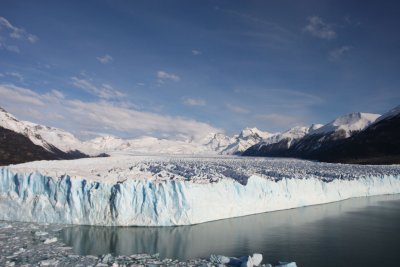
A general view shows the Perito Moreno Glacier in Los Glaciares National Park, southern Argentina, in 2016. The glacier, one of Patagonia’s top tourist attractions, is entering a phase of rapid retreat that experts say is irreversible. Photo by EPA
Aug. 22 (UPI) — Argentina’s iconic Perito Moreno glacier, one of Patagonia’s top tourist attractions, is entering a phase of rapid retreat that experts say is irreversible.
For decades, the massive ice formation was considered an exception. While most glaciers in the region were shrinking, Perito Moreno held a fragile balance. Its towering wall over Lake Argentino and dramatic ice ruptures — which attract large numbers of tourists from the city of El Calafate — made it one of the region’s most famous natural landmarks.
But a study published in Communications Earth & Environment has raised alarms. Led by German and Argentine scientists, the study found that the glacier has been retreating rapidly since 2019 after remaining nearly stable until then.
Between 2000 and 2018, its thinning rate was about 1 foot a year. That rate jumped to 18 feet a year between 2019 and 2024. In some areas, the glacier has retreated more than 2,600 feet in just five years.
The Perito Moreno glacier, located in Los Glaciares National Park, spans about 97 square miles, nearly one and a half times the size of Washington, D.C. Between 2018 and 2025, it lost about 0.7 square miles, equivalent to roughly 320 soccer fields.
Designated a UNESCO World Heritage Site in 1981, it is one of the few glaciers in the world easily reached by land. That accessibility, along with its dramatic rupture and lake-damming events and the infrastructure built around it, has made it a major tourist attraction.
The study — which combined satellite data, airborne radar surveys and sonar measurements from the lake — also found that the glacier is losing contact with a subglacial ridge that historically provided stability. If the separation continues, the glacier could collapse and retreat several miles, driven by water building beneath the ice.
From a tourism perspective, the shift means the glacier’s iconic ruptures — the massive icefalls once thought eternal — could become more frequent, but now with the melancholy of knowing the spectacle may not last.
Scientists say the retreat is part of a “delayed response to climate change,” resulting from decades of warmer temperatures and reduced snowfall. Over the past three decades, average summer temperatures in the region have risen by 2.2 degrees Fahrenheit. The 2023-24 summer was the warmest in 30 years, reaching 52°F.
Los Glaciares National Park held about 150 active glaciers in 1850. By 2015, only about 26 remained.